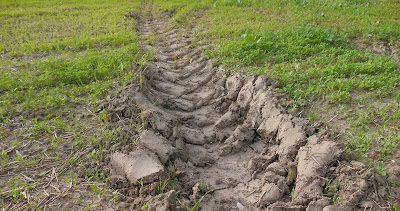Soil compaction is the process by which soil particles are pressed together, reducing the spaces (pores) between them. This occurs when soil is subjected to pressure from heavy machinery, livestock, or even excessive foot traffic. Compaction is problematic for plant growth because it limits root penetration, reduces water infiltration, and can lead to poor soil aeration.
Causes of Soil Compaction
-
Heavy Machinery:Tractors, construction vehicles, and other heavy equipment can compress soil, particularly in agricultural and urban areas.
-
Livestock and Foot Traffic:Livestock grazing or excessive human foot traffic, especially in wet conditions, can compact the soil surface.
-
Repeated Tillage:Frequent tillage, especially at shallow depths, can lead to the formation of a plow pan—a compacted layer beneath the surface that restricts root growth.
-
Wet Soil Conditions:Compaction is more likely to occur when the soil is wet, as moist soil particles are more easily compressed.
-
Improper Irrigation or Watering:Over-irrigating can lead to soil becoming too soft and prone to compaction under pressure.
Effects of Soil Compaction
-
Reduced Root Penetration:Compacted soil makes it difficult for plant roots to grow deep or spread out. This can lead to stunted plant growth and poor yield.
-
Poor Water Infiltration:Soil compaction leads to reduced pore space, making it harder for water to penetrate the soil. This can lead to water runoff, erosion, and poor soil drainage.
-
Reduced Oxygen Flow:Compaction decreases the amount of air in the soil, limiting oxygen availability for plant roots and soil microorganisms. This can stunt root development and hinder soil health.
-
Increased Erosion Risk:The compacted soil surface is less able to absorb water, leading to increased runoff. This can carry away topsoil, further degrading the land and causing erosion.
-
Impaired Microbial Activity:Soil compaction can limit the movement and activity of beneficial microorganisms, which are essential for nutrient cycling and organic matter decomposition.
Signs of Soil Compaction
-
Stunted Plant Growth:Plants may show signs of poor growth or yellowing leaves due to restricted root growth and nutrient uptake.
-
Water Puddling:Water may pool on the surface of compacted areas, as it struggles to infiltrate into the soil.
-
Hard Soil Surface:Walking or driving on compacted soil may create visible depressions or hardened areas where the soil feels unnaturally firm.
-
Root Problems:Roots may appear shallow, bent, or deformed as they struggle to grow through compacted layers.
Prevention and Solutions for Soil Compaction
-
Avoiding Overuse of Heavy Machinery:Minimize the use of heavy machinery, especially when soil is wet. When machinery is necessary, use equipment designed to reduce pressure on the soil.
-
Crop Rotation and Reduced Tillage:Practices like no-till farming or minimum tillage reduce soil disturbance and help maintain soil structure. Rotating crops also reduces soil compaction caused by repeated planting of the same crops.
-
Using Cover Crops:Planting cover crops such as legumes can help improve soil structure. Their roots break up compacted layers, allowing for better water infiltration and root growth.
-
Aeration:Regularly aerating the soil using tools like aerators or spiking machines can help alleviate compaction. Aeration is especially helpful for compacted lawn or garden soils.
-
Reducing Foot and Livestock Traffic:Limiting foot traffic or rotating grazing areas for livestock can help prevent further soil compaction in sensitive areas.
-
Amending the Soil:Adding organic matter (compost or mulch) can help improve soil structure, increase porosity, and reduce compaction. Organic matter helps to bind soil particles together and improve the movement of water and air.
-
Proper Irrigation:Avoid over-irrigating, and ensure that water is evenly distributed to prevent waterlogging or soil softening that leads to compaction.
-
Deep Tillage for Severe Compaction:In extreme cases of compaction, deep tillage (subsoiling) may be necessary to break up hardpan layers beneath the surface. However, this should be done sparingly, as it can cause further disruption to the soil structure if overused.
Long-Term Solutions
- Soil Health Management:Focus on building healthy soils through practices like organic matter addition, composting, and organic farming techniques to prevent long-term compaction.
- Soil Testing:Conduct regular soil testing to monitor for compaction and other soil issues, which can guide management decisions and practices to improve soil health.











Hiç yorum yok:
Yorum Gönder
Yorumunuz İçin Teşekkürler